The modern world of landscape design is simply abounding with a huge number of different decorative plants that take an active part in creating unique and spectacular garden compositions. It is difficult to find a household plot today, where at least one bush of an excellent hydrangea grew - one of the most decorative and popular cultures that are famous for their appearance and unpretentious care.
Hydrangea Miscellaneous, one of the types of this plant, has a large number of varieties, among which special attention should be paid to the hydrangea Great Great Star - a very bright and unusual bush with snow-white flowers similar to the stars. Putting on its site this kind of decorative shrub, you can admire the lush flowering of hydrangea for many weeks, while not making great efforts when planting and leaving the plant.
In this article, consider the features and description of the hydrangea Great Star, we note the basic uses of the variety of a decorative plant in landscape design. We give the basic principles and rules for landing and care for Hydrangea by the Miscellaneous "Great Star".
Features and morphological description Hydrangea Great Star
Hydrangea Miscellaneous in recent years has become the most popular species of this decorative plant. The aggregate of excellent winterinsuit, unpretentiousness in care, an excellent appearance makes this culture simply indispensable for growing in the middle strip. Hydrangea Miscelred is considered perhaps the largest variety that undoubtedly attracts the attention of gardeners and landscape designers. Features of the species were first described by German scientists and naturalist Phillip Franz von Zibold in 1829 in Japan. It is in this country that the decorative plant was grown especially actively in various nurseries. Natural habitat Hydrangea Miscellaneous Great Star is a subtropical and moderate climatic zone.
It is a unique and incredibly beautiful hydrangea variety was removed in France in famous gardens of the French princess Greet Sturge, who really loved to grow different cultures. That is why many amazing varieties of decorative plants appeared in this garden. The name of the hydrangea name of the Great Star in translated from English indicates a "large or big star", which is most likely due to the appearance of colors. One of the types of colors in inflorescence has 4 petals and very much reminds the star.
Great Star Hortensia variety was bred not so long ago, however, due to its large decorative value in the form of large snow-white inflorescences, this plant is simply very popular with gardeners. This spectacular plant cannot leave anyone indifferent, even people far from growing flowers and other cultures.
Description Great Great Star:
- Miscellaneous hydrangea Great Star is a decorative, decorative, beautifully blooming shrub or a small tree, which refers to the genus of hydrangea and Hydrangea Paniculata, as well as to the total type of hydrangea and the large family of encounter. This is a variety - one of the few dozen varieties of garden hydrangea, which are very popular with gardeners.
- Most often, you can grow this plant in the form of a decorative shrub with a spreaded crown, less often meet hydrangea Great Star Tree-shaped.
- The root shrub system is a rather extensive and highly branched rhizome, which is located close to the surface, so it is necessary to be very careful when the richetic circle is loose.
- Hydrangea Miscellaneous Great Star has a rather sparky crown, which can grow to a height of up to 2-3 meters. In diameter, the shrub of a decorative plant can also be very extensive and range to about 1.5-2 meters. This hydrangea grade is considered fast, since in one year the bush may be increasing by 15-17 cm.
- The plant itself is formed by reprehensive strong shoots, which in the first year have a green shade, and in the second year they begin to rush and acquire brown color.
- Savages are thick covered with opposite leaves, which have a dark green shade.
- The leaves of simple shape, wide enough, oval. Sheet plate slightly wrinkled and shiny.
- Hydrangea Handicap Great Star has high decorativeness even during the growing season, as large foliage looks very impressive on shoots.
- This grade of hydrangea has one obvious difference from other varieties of culture - unusual inflorescences.
- During flowering on the tops of the shoots, beautiful and neat inflorescences are formed in the form of the correct cone. They are large enough and dense, in length can reach about 17-25 cm.
- The originality of the inflorescence is the presence of two kinds of flowers on them. Some flowers are large enough, can reach about 7-10 cm and consist of 4 long and slightly twisted petals that resemble a propeller or four-pointed star. These sterile flowers. There is one more type of colors - fertile or fruiting, which are very small and numerous. In one inflorescence of such flowers can be up to 200 pieces.
- Flowers have a snow-white shade, which gradually can become bluish or pink, depending on the composition of the soil - sour or alkaline.
- The flowering of hydrangea of \u200b\u200bthis variety begins at the beginning or in mid-July and lasts until October. This feature of the decorative plant is particularly attracted by gardeners, as you can admire the beautiful and magnificent blossoms of busta for a long time.
- Hydrangea Great Star has a good winter hardiness - a bustery can withstand frosts up to minus 30 degrees, which contributes to the normal cultivation of culture in the middle lane of Russia and even in Siberia. In addition, culture is famous for good resistance to diseases and pests.
- Despite the worship of the landing and the composition of the soil, this plant today is a frequent guest in the household sections.
Using Hydrangea Great Star in Landscape Design
As noted above, all varieties and varieties of hydrangea are highly decorative, which led to the vast popularity of this culture among gardeners and landscape designer. The grade of the Battle Great Great Star is a bright and spectacular shrub that can become an excellent element of any garden composition. Consider several basic applications of this plant in the decoration of the household site.
- First of all, it is worth noting that this grade of hydrangea looks great as a solitator. Such a bush can be easily planted against the background of a green lawn or near the construction. With its appearance, he can decorate even the most unpretentious walls.
- Group landing from hydrangea Great Star is very original. Putting several plants seedlings nearby, you can expect a small but very bright blooming cleaner in the future. In addition, the chipsticks of the hydrangea of \u200b\u200bthis variety can be combined with both other types of hydrangeas and with completely other decorative plants.
- You can land the bunches of hydrangea with snow-white original colors along the garden tracks or along the border, thereby creating a peculiar live elevation.
- Many gardeners plant Saplings Hortensia Great Star in Mixlers and Alpine Hills, creating wood-flower groups.
- This variety of decorative plants can also be used to decorate recreation areas, terraces and arbors.
Great Great Great Great Stand: The most common ways
At its plot, Hytenzia Metulaty Great Star will not be difficult, subject to the main rules and stages of landing and care, as well as with a clear observance of the technology of the main methods of reproduction of this culture. To make such a unique decorative plant, you can take advantage of the following methods: reproduction of rhizomes, stalling, decodes and seeds. Each specified method has its own characteristics and characteristics that are important to consider to obtain full-fledged young plants.
Dividing root
- This method of reproduction is recommended to be used only for young plants, since over the years the root system is greatly growing and therefore it will be difficult to divide it.
- Conduct the division of Hydrange Sustainer by the Great Star, you can in spring or in autumn. However, with the second option, it is important to think in advance about the insulation of the root system so that the young plant is not freezing in winter.
- First of all, it is necessary to carefully remove the plant from the soil. For this, the shovel neatly the soil around the bustle is neatly drunk, so as not to damage the roots, and then the entire plant is digging.
- Next, you need slightly eliminate the root system from the soil.
- At the next stage, the rhizome of the hydrangea of \u200b\u200bthis variety should be divided into several parts in such a way that each decene has several young kidneys of growth.
- Pre-prepare landing points, as the decene needs to immediately plant in the ground.
- In the wells, it is necessary to add fertilizers and the rooting agents to better root the seedlings.
- After landing, the deteen is plenty of water.
Pencornia reproduction
- This method of breeding a decorative plant is used much more often, as it allows you to receive young hydrangea seedlings by the burden of this variety every year. In addition, the process of their production does not differ in great complexity and does not take much time.
- To get beautiful young plants, it is important to choose the right time to cut the cuttings. It is best for this suitable June, when annual shoots are completely ripening. It is not necessary to harvest the planting material in spring and autumn, as they are characterized by poor survival.
- It is important to clearly observe all the rules for cutting cuttings. First of all, they should be about 12-15 cm long and have at least three pairs of kidneys. The lower slice should be approximately 2 cm below the kidney, and the upper one is 5 cm above the kidney.
- Preparing cuttings for rooting, you need to remove all the lower leaves, and the remaining top to shorten the half.
- Hydrangea Miscellaneous Great Star is considered a capricious plant, so it is important to carefully prepare them before landing. For this, the prepared landing material is necessary to dug in water for several days and must be treated with growth stimulants.
- For rooting cuttings, it is important to prepare suitable containers or wooden boxes in advance, which you need to fill with sand and peat in a ratio of 1 to 2.
- The cuttings are rooted at a small angle, blocking them about 2/3.
- From above, the container must be covered with a film or glass, as an option, each cutlets can be individually covered with a plastic bottle.
- After that, the containers are exhibited on an open air into a small shadow.
- Further care for young plants will be in daily spraying and irrigation, since hydrangea is considered a moisture-loving plant.
- The first roots will appear in Cherenkov after about 3 weeks, after which shelter is removed and regular watering continues.
- At winter, containers with cuttings need to be transferred to a cool room without freezing.
- In the open ground, the seedlings are planted only in August next year, while several years of plants need to be stolen for the winter. Recommended the first years to cut down the boutons that the plants are gained.
Reproduction by chains
- Many gardeners use this method of reproduction that does not take a lot of time and effort.
- It is recommended to conduct it in spring time before the period of active vegetation.
- First of all, on an adult bushes of hydrangea, the Great Star must choose young and well-ridden side shoots.
- Next, under the selected shoots in the soil you need to make grooves or wells.
- Before you hurt shoots in the groove, you need to make small cuts on them, where the roots will germinate.
- Grip the grooves to the furrocks and spray them soil mixture so that the tip of the escape is upstairs in a vertical position.
- So that the branch does not return to its original position, it must be fixed using a special bracket or simply press the stone.
- In about the year after the next spring, you can see young processes, however, it is recommended to separate the chains from adults in adult. It is necessary in order for young plants to type forces and in the future more easily moved the transplant.
Planting hydrangea Great Star - Phased description
Landing any decorative plant is a responsible and serious process that requires careful preparation and attention of the gardener. The same applies to the cultivation of hydrangea of \u200b\u200bthe Great Great Star, which is also a fairly whimsical and capricious plant regarding the choice of soil and landing sites. In the end, you are pleased with a beautiful flowering plant, it is necessary to study all the requirements of this hydrangea variety to planting technology. Consider the main stages of the culture of culture on its plot.
Stage 1. Choice and acquisition of hydrangea seedlings Great Star
- First of all, each gardener needs to think about the acquisition of high-quality and healthy hydrangea seedlings of this variety.
- You can buy Great Star Hortensia in any garden center or agrofirma, which is professionally engaged in breeding plants. Acquire the planting material of such a plant in the natural markets or unverified people can lead to the fact that there will be a completely different variety of decorative plant on your site. In this case, it is best to contact professionals.
- It is recommended to buy seedlings that have already achieved 3-4 years of age. They are better adapted to the environmental conditions and can be bloated in the year of planting.
- On the shelves, most often you can find seedlings of hydrangea of \u200b\u200bthe springtime of this variety with a closed root system - seedlings in small pots. This facilitates the life of gardeners, as such seedlings can be planted throughout the season.
- Before buying, it is necessary to carefully check the purchased instances. On the top, the plant should not be visible damage, dry and yellowed sites, as well as signs of diseases and pests. In addition, the soil in containers should be clean, without weed and moisturized, which indicates that the young plants are careful.
Stage 2. Choice of Place and Pouring Soil for Planting
- The second important step to getting a beautiful and magnificent blooming busta is the right selected landing site Great Star.
- This plant prefers to grow on a slightly shaded area, since under the right sunny rays, the bus stops developing, and inflorescences become small.
- The selected landing place should be on the warmth and sunny plot, where the same moisture-loving plants are not growing in the neighborhood, as well as the hydrangea Great Star. They simply will interfere with each other.
- The plot must be protected from strong wind and drafts that can break the shoots.
- Hortensia Great Star is very whimping in relation to the soil. It is important to choose a plant with a light, moistened, fertile soil, which necessarily has a weakly acid or acidic reaction. It is not recommended to land seedlings into the ground, in which there are noisters, for example, lime.
- Before boarding, it is important to switch well and explode the soil on the selected area, remove all weeds and roots.
Stage 3. The process of planting hydrangea Great Star in Open ground
- Seedlings of hydrangea of \u200b\u200bthis variety can be as spring immediately after complete heating of the soil and in the fall. However, when choosing a second option, you need to be ready to hide the young plants that can freeze a little.
- Before boarding, it is first necessary to dig up the landing wells, the size of which depends on the size of the root system of culture seedlings. The depth of the landing pits should be 50-60 cm on average, the width is 70-80 cm. If you disembark a few bushes of hydrangea Great Star next, do not forget to leave the distance between the seedlings. It should be approximately 1.5-2.5 m, which depends on the landing appointment.
- The bottom of the landing pit and the container with a sapling must be pre-pouring water.
- While the moisture will be absorbed, prepare the soil mixture. Add sand, peat and humus to the ground out of the pit, as well as pour 25 grams of potassium sulfate, 25 grams of urea and 65 grams of superphosphate.
- At the bottom of the pits, pour a small layer of drainage from broken bricks or small stones, on top of which part of the fertile soil is placed.
- Plant seedlings neatly lower on the hilmik and pour them with a soil pressing the surface with hands. It is important to remember that the root neck must be slightly higher than the soil level.
- After landing, young plants should be abundantly pouring, and the rolling circle is well meditated by sawdust, a cheese or peat to prevent the rapid evaporation of moisture.
Agrotechnology of Great Great Great Star: Secrets and Nuances of Care
If you correctly landing the hydrangea Great Star, then the care of this excellent plant is not much difficult.
- Watering. Hydrangea Miscellaneous of this variety is considered a moisthed plant, so watering is considered one of the most important stages of culture care. On one bush should have about 3 water buckets. At the same time, it is necessary to water the plants at least 1 time per week, and at the tightening heat this quantity increases. It is recommended to navigate on the state of the soil - the surface should always be moistened.
- Loosening and mulching. Periodically, the rolling circle should be cleaned from the weeds that appeared, as well as neatly loose, it is thus saturated with oxygen. To reduce the amount of loosenings and irrigation, it is recommended to climb ground under the bushes. To do this, you can pour a layer of sawdust or needles, and you can plant soil plants.
- Feeding In order for the chickens of Hydranges by the Great Great Star, pleased with their beautiful appearance and lush flowering, it is necessary to take care of timely feeding. In just season you need to make fertilizer 4 times. The first time the chickens of the hydrangea of \u200b\u200bthis variety feed the early spring before the start of the juice movement. At this time, it is best to use organic fertilizers, such as a cowboat solution. The second dressing is carried out during the formation of buds, when plants need to be easily supported by sulfate potassium, urea and superphosphate. For the third time, hydrangea is fed in the middle of summer using complex mineral fertilizers. The last time the plant fell pi preparation for winter. In this case, it is recommended to use special compositions without nitrogen.
- Trimming. In order for the horticulture bushes, a beautiful and neat appearance, it is necessary to trigger. Each spring you need to remove damaged and frostbed shoots. To the time of the young plant immediately after landing, it is recommended to remove all the inflorescences so that the plant sends all the nutrients into the root system. When rejuvenating trimming, it is necessary to trim all shoots, leaving only 5-6 cm.
- Shelter for the winter. Despite the fact that the hydrangea Great Star is considered a winter-resistant plant, it is necessary to take care of the shelter before the onset of cold weather. For this, the root system is covered with a layer of peat, humus and fallen leaves, which should be approximately 20 cm. After the snow loss around the coastal is built a snowdrift. In the spring you need to remove the shelter in time so that the plant does not start to hide.
Hydrangea Great Star - Photo
According to numerous reviews, Great Star Hortensia is considered an excellent representative of this species. Putting such a bush once on his site, you no longer wanted to admire other plants, as the hydrangea of \u200b\u200bthis variety includes a beautiful appearance, and magnificent spectacular flowering, and excellent climate resistance. All this undoubtedly attracts gardeners and landscape designers.

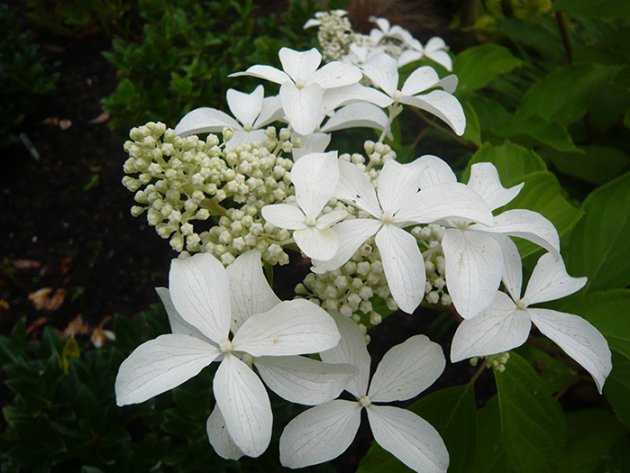
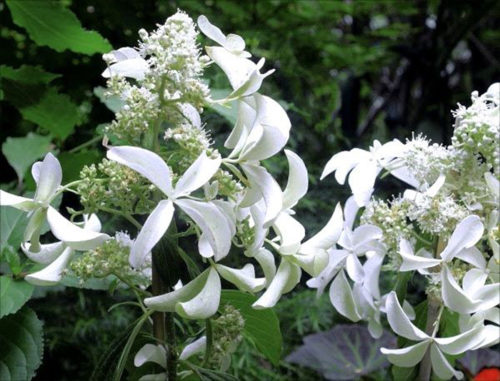
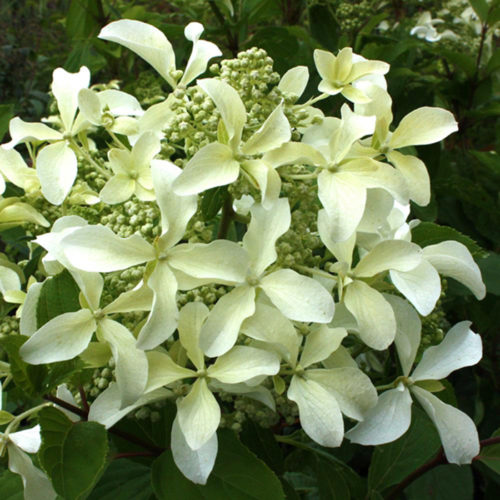
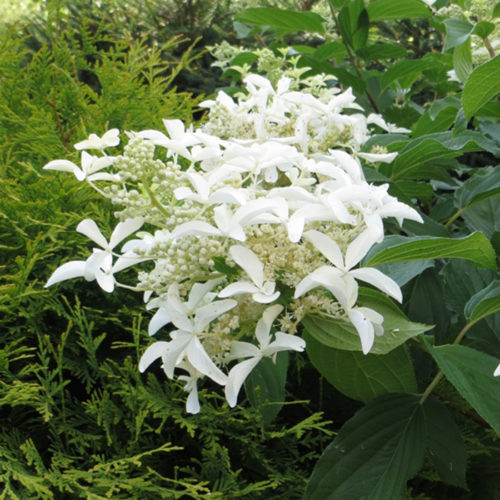
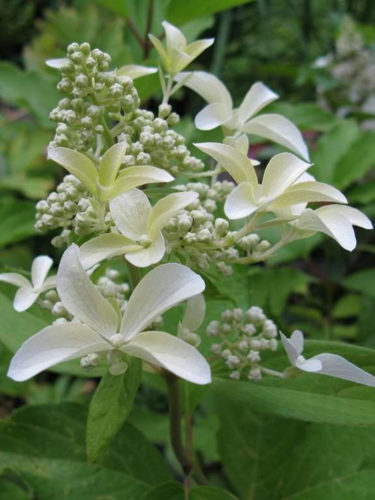
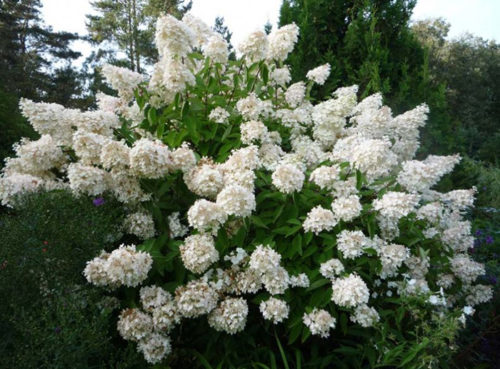
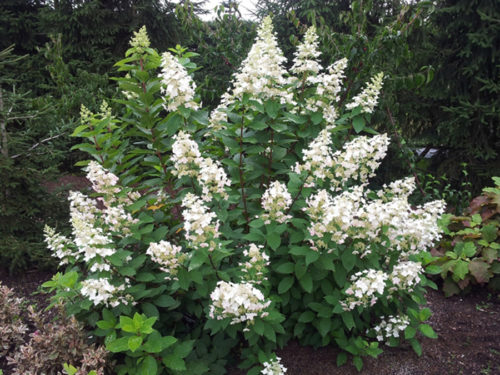
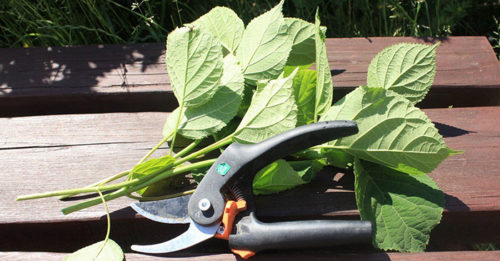
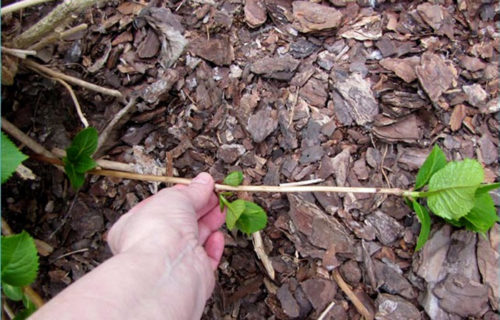
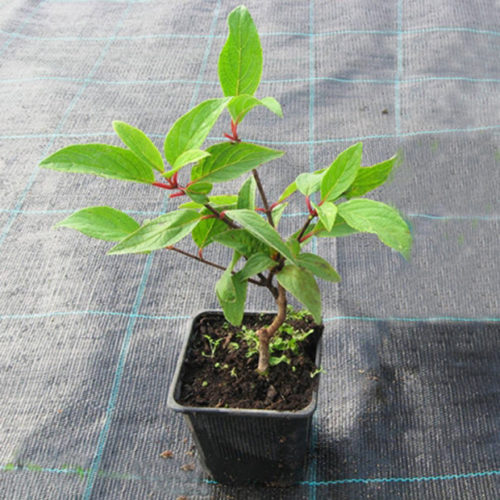
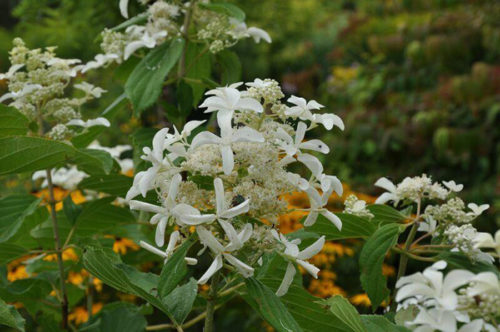
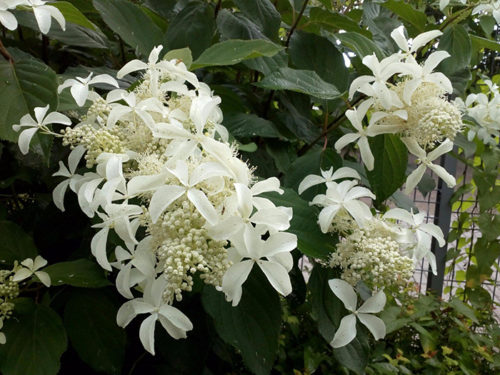
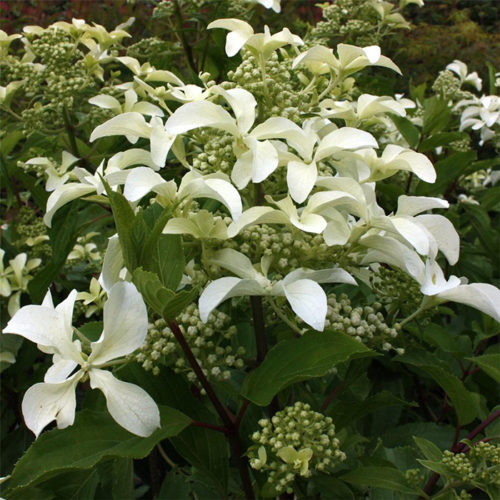
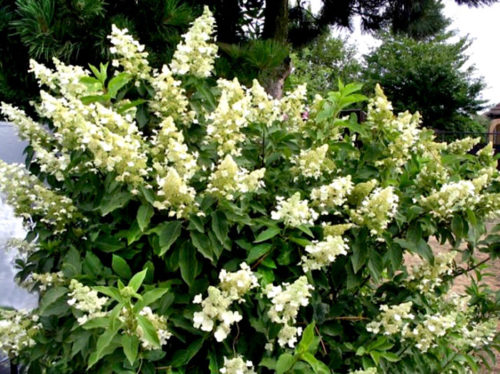
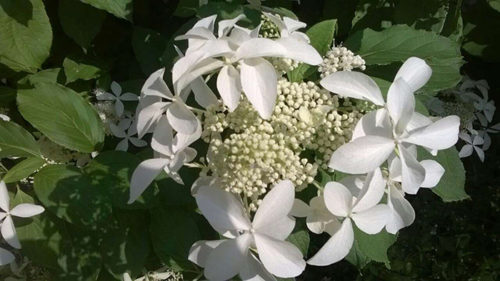
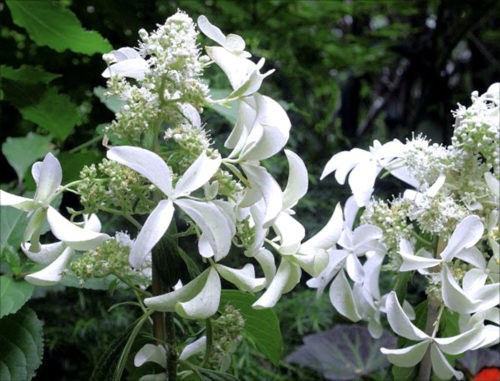
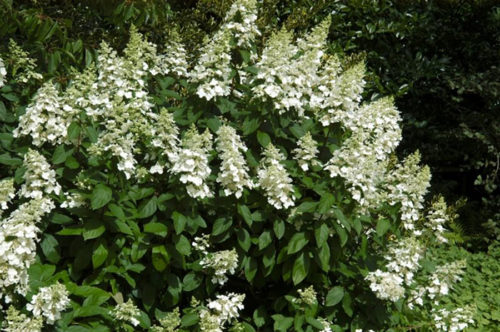












 Start a discussion ...
Start a discussion ...